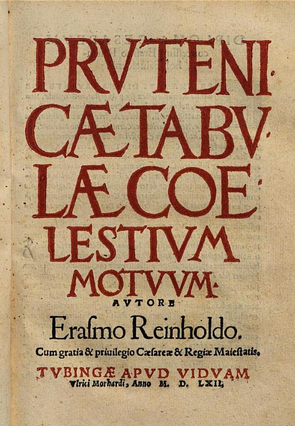
Erasmus Reinhold (1511 – 1553)
On October 22, 1511, German astronomer and mathematician Erasmus Reinhold was born. He is considered to be the most influential astronomical pedagogue of his generation. Furthermore, he is best known for his carefully calculated first set of planetary tables applying Copernican theory, published in 1551.
Erasmus Reinhold Background
Erasmus Reinhold was born and died in Saalfeld, Thuringia, Germany. His father Johannes Reinhold was a tax collector. In 1530 went to Wittenberg to study at the Academia Leucorea under Jacob Milich, from where he graduated in 1535 as Magister. In 1536 he was appointed professor of higher mathematics by Philipp Melanchthon.[9] In contrast to the limited modern definition, “mathematics” at the time also included applied mathematics, especially astronomy.
Astronomy
His colleague, Georg Joachim Rheticus,[4] also studied at Wittenberg and was appointed professor of lower mathematics in 1536. Reinhold catalogued a large number of stars. In summer 1549 he became dean of the artistic faculty and one year later principal of the university Wittenberg. His publications on astronomy include a commentary on Georg Purbach‘s Theoricae novae planetarum. Reinhold knew about Nicolaus Copernicus and his heliocentric ideas prior to the publication of De revolutionibis and made a favourable reference to him in his commentary on Peuerbach.[3,5]

Frontpage of first edition Erasmus Reinhold’s Prutenic Tables’ (1551)’
Planetary Tables
However, Reinhold like other astronomers translated Copernicus‘ mathematical methods back into a geocentric system, rejecting heliocentric cosmology on physical and theological grounds. In 1551, Duke Albert of Brandenburg Prussia supported Reinhold and financed the printing of Reinhold’s Prutenicae Tabulae or Prussian Tables, upon which Reinhold spent seven years labour. These astronomical tables helped to disseminate calculation methods of Copernicus throughout the Empire. Both Reinholds’s Prutenic Tables and Copernicus‘ studies were the foundation for the Calendar Reform by Pope Gregory XIII in 1582. With his tables, Reinhold intended to replace the Alfonsine Tables; he added redundant tables to his new tables so that compilers of almanacs familiar with the older Alfonsine Tables could perform all the steps in an analogous manner.[6] It is significant that Tycho Brahe was so interested in Reinhold’s measurements that he himself made the journey to Saalfeld to see Reinhold.[8]
The Copernican Revolution
Copernicus’s heliocentric claims did not, then, win over the hearts of all European astronomers overnight. Rather, the Prussian Tables became popular in German speaking countries for nationalistic and confessional reasons, it seems, and it is through these tables that Copernicus’s reputation was established as a skilled mathematician or an astronomer on a par with Ptolemy, and helped to disseminate the Copernicus‘ methods of calculating the positions of astronomical objects throughout the Holy Roman Empire.
Erasmus Reinhold died in 1553 in Saalfeld because of a lung disease at age 42.
Nathan Feldmeth, “The Copernican Revolution & the Reformation in Northern Germany”, [14]
References and Further Reading:
- [1] Erasmus Reinhold Biography at MacTutor History of Mathematics
- [2] Copernicus and Astronomical tables
- [3] Nikolaus Copernicus and the Heliocentric Model, SciHi Blog
- [4] Georg Joachim Rheticus’ Achievements for Astronomy, SciHi Blog
- [5] Georg von Peuerbach – Astronomy at the Beginning of the Scientific Revolution in Early Modern Age, SciHi Blog
- [6] Alfonso X from Spain and the Alfonsine Tables, SciHi Blog
- [7] Tycho Brahe – The Man with the Golden Nose, SciHi Blog
- [8] Erasmus Reinhold, Prutenicae Tabulae Coelestium Motuum. Tubingae 1551
- [9] Philipp Melanchton – the First Systematic Theologician of the Protestant Reformation, SciHi Blog
- [10] Siegmund Günther: Erasmus Reinhold. In: Allgemeine Deutsche Biographie (ADB). Band 28, Duncker & Humblot, Leipzig 1889, S. 77–79.
- [11] Andreas Kühne: Reinhold, Erasmus (d. Ä.). In: Neue Deutsche Biographie (NDB). Band 21, Duncker & Humblot, Berlin 2003, S. 367 f.
- [12] Erasmus Reinhold at Wikidata
- [13] Not with a bang but a whimper, The Renaissance Mathematicus, Oct 5, 2022
- [14] Nathan Feldmeth, “The Copernican Revolution & the Reformation in Northern Germany”, Concordia University Irvine @ youtube
- [15] Erasmus Reinhold Timeline via Wikidata






Dear Sirs,
may I recommend my very special Reinhold – link to you??
“Reinhold on the Moon – a French Connection”
http://www.ta-dip.de/dies-und-das/r-e-i-n-h-o-l-d.html
With kind regards!
Reinhold Kriegler
Thanks for the link 😉
Dear Harald Sack! Thank you for your reply! I saw it a bit late on September 15, 2015